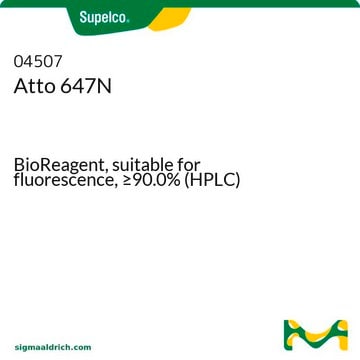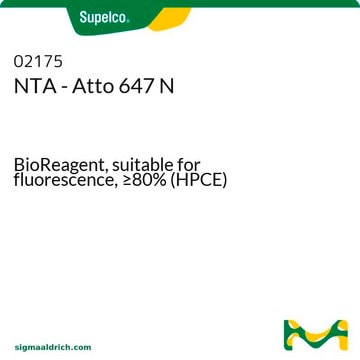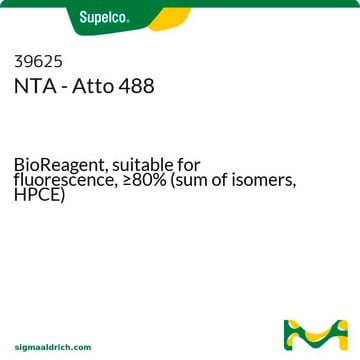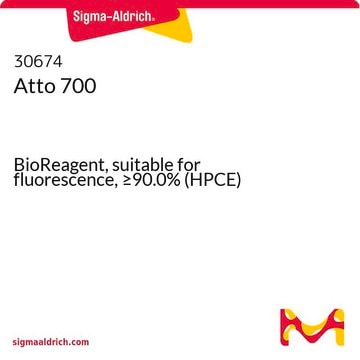97875
Atto 647
BioReagent, suitable for fluorescence, ≥90% (HPCE)
Sign Into View Organizational & Contract Pricing
All Photos(1)
About This Item
Recommended Products
product line
BioReagent
Assay
≥90% (HPCE)
form
powder
manufacturer/tradename
ATTO-TEC GmbH
transmittance
254 nm
647 nm
fluorescence
λex 643 nm; λem 665 nm in 0.1 M phosphate pH 7.0
λ
in ethanol (with 0.1% trifluoroacetic acid)
UV absorption
λ: 645-651 nm Amax
suitability
suitable for fluorescence
storage temp.
−20°C
General description
Atto 647 is a zwitterionic dye with a net electrical charge of zero. It is a pH sensitive product. While practically stable up to pH 8.5, it slowly degrades at higher pH. Atto 647 is a new label with high molecular absorption (120,000) and quantum yield (0.20) as well as enough Stokes shift between excitation and emission maximum. Atto 647 is characterized by a high photostability and brightness. In addition, this label has good water solubility and low triplet formation ability.
Application
Atto fluorescent labels are designed for high sensitivity applications, including single molecule detection. Atto labels have rigid structures that do not show any cis-trans-isomerization. Thus these labels display exceptional intensity with minimal spectral shift on conjugation.
Storage Class Code
11 - Combustible Solids
WGK
WGK 3
Flash Point(F)
Not applicable
Flash Point(C)
Not applicable
Personal Protective Equipment
dust mask type N95 (US), Eyeshields, Gloves
Certificates of Analysis (COA)
Search for Certificates of Analysis (COA) by entering the products Lot/Batch Number. Lot and Batch Numbers can be found on a product’s label following the words ‘Lot’ or ‘Batch’.
Already Own This Product?
Find documentation for the products that you have recently purchased in the Document Library.
Customers Also Viewed
Cytokinesis,Volume 137 of Methods in Cell Biology (2017)
Daniel Puntener et al.
Journal of virology, 85(1), 481-496 (2010-11-05)
Human adenoviruses (Ads) replicate and assemble particles in the nucleus. They organize a linear double-strand DNA genome into a condensed core with about 180 nucleosomes, by the viral proteins VII (pVII), pX, and pV attaching the DNA to the capsid.
Duncan Hill et al.
Biomedical microdevices, 13(4), 759-767 (2011-05-12)
This paper presents an overview of development of a novel disposable plastic biochip for multiplexed clinical diagnostic applications. The disposable biochip is manufactured using a low-cost, rapid turn- around injection moulding process and consists of nine parabolic elements on a
Laura Pastorino et al.
Journal of colloid and interface science, 357(1), 56-62 (2011-02-26)
The protein collagen is the major component of connective tissue and it is involved in many biological functions. Its degradation is at the basis of different pathological processes. The up-regulated expression of matrix metalloproteinases and the down-regulated expression of their
Emmanuel G Guignet et al.
Chemphyschem : a European journal of chemical physics and physical chemistry, 8(8), 1221-1227 (2007-04-17)
Sensitive live-cell fluorescence microscopy and single-molecule imaging are severely limited by rapid photobleaching of fluorescent probes. Herein, we show how to circumvent this problem using a novel, generic labeling strategy. Small nickel-nitrilotriacetate fluorescent probes are reversibly bound to oligohistidine sequences
Our team of scientists has experience in all areas of research including Life Science, Material Science, Chemical Synthesis, Chromatography, Analytical and many others.
Contact Technical Service





